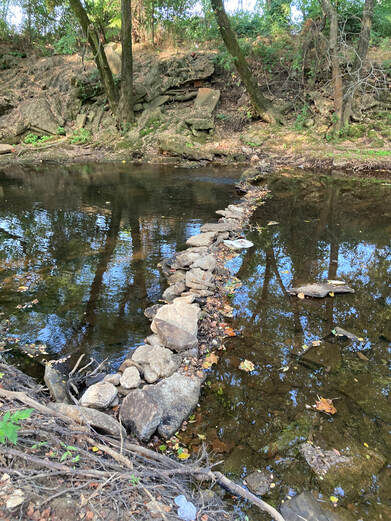Dams Can Be Removed
- Rebecca Jim
- Aug 5, 2022
- 3 min read

"There are places you will remember"... are words from a song you may remember. But the places you remember, yours and mine, may differ of course, but if you have walked along the shores of a stream, a river or a creek, you will recall the sound and the movement of the water as it flowed past you and continued on its work to reach the ocean, like seeking its long lost mother.
Perhaps it may have lapped to the shore and reached your feet and slid back away only too quickly. It is a beautiful sight. But seeing trapped water, held back and turning black, gathering and beginning to "scum" over can move you and others to action: To free that water and allow that water to move as it was created to do. Monday morning made it a thing your Waterkeepers did. We took down the latest dam that had been built to stop her flow, went to our office, put on dry boots and led a US Senate candidate on his Toxic Tour.
As a child, is Tar Creek a place you remember? If you were an NEO student, how did her proximity become layered into your memories? If you live along her, on the corridors we know as riparian zones did she rush into your home? lap onto your yard? enter your swimming pool like she and her teammate the Neosho River did with the BIG POOL in Riverview Park?
These waters flow and butt into the water stacked in the Grand Lake o' the Cherokees and never turns around to see which way they back up on us. Ever backed a boat down to the water? It isn't always pretty to watch and neither is that water backing up across the Steve Owens Blvd.
We bemoan and demean that lake and the people who operate the gates that keep our backwater coming back to us. Lots of other people have felt that same way. Many are way ahead of us with the anger, the disgust, and the drive they have to STOP that from happening again.
These waters remember how they flowed unrestrained, they sing it when they meet at Twin Bridges. Other rivers have known freedom, then containment and every year throughout the nation, these rivers are not singing loud enough, but there is a movement to free these trapped waters and let the forces they contain reach the sea.
As we know, a dam can be built to hold water back and while storing it, control flooding, and may even generate electricity. But outdated dams pose a threat to public safety. A recent UN report highlighted the growing risk of aging water infrastructure.
There was a "big dam" building phase in the US beginning in the early 1900's and President Franklin Roosevelt used dam building to put many people to work during the Depression. Our Grand Lake got in on the tail end of that era and is now over EIGHTY years old and GRDA is asking for a 30 to 50 year license to continue generating power. It is hard to believe that there are more than 90,000 dams blocking rivers in the U.S.
"90 dams in the US were removed in 2020. A total of 1,797 dams have been removed in the U.S. since 1912."

The movement to capture nature and USE her has met the challenge of old dams and trapped water also trapping sediment and pollutants, these aged-out infrastructures have gotten the attention of protectors: water protectors, the Salmon protectors, the flat heads and the cultures that have been spinning in place to reclaim their origin stories and follow the food that lives in the waters that flow through ancestral lands.
https://education.nationalgeographic.org/resource/dams
Our Grand Lake has been the stopped up sink catching the metals from Tar Creek for almost half her lifespan which is why DEQ posted the fish advisory for many of our fish for lead in 2007.

What happens to our flooding if not only the operation of the dam worked in our favor, or if the dam was removed? "There are places you will remember..." perhaps the lake when the water was clear? When you were allowed to swim in it as a child? Will we begin to consider what other communities have? Will we free these rivers? Or are we satisfied with the lake we have and the flooding that comes?
Leaving you with another possible way to prevent flooding.
Respectfully Submitted ~ Rebecca Jim

Comments